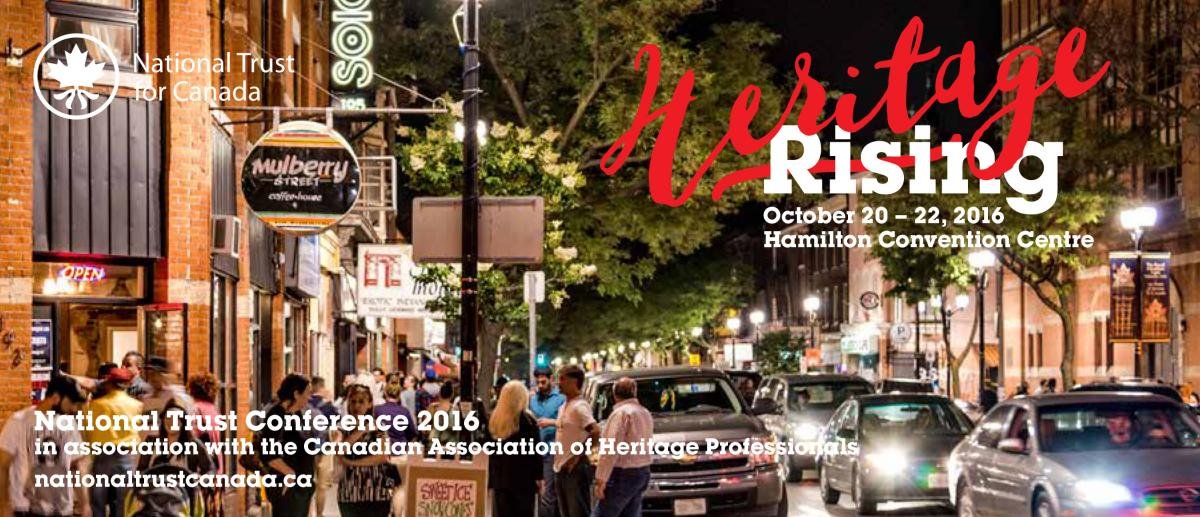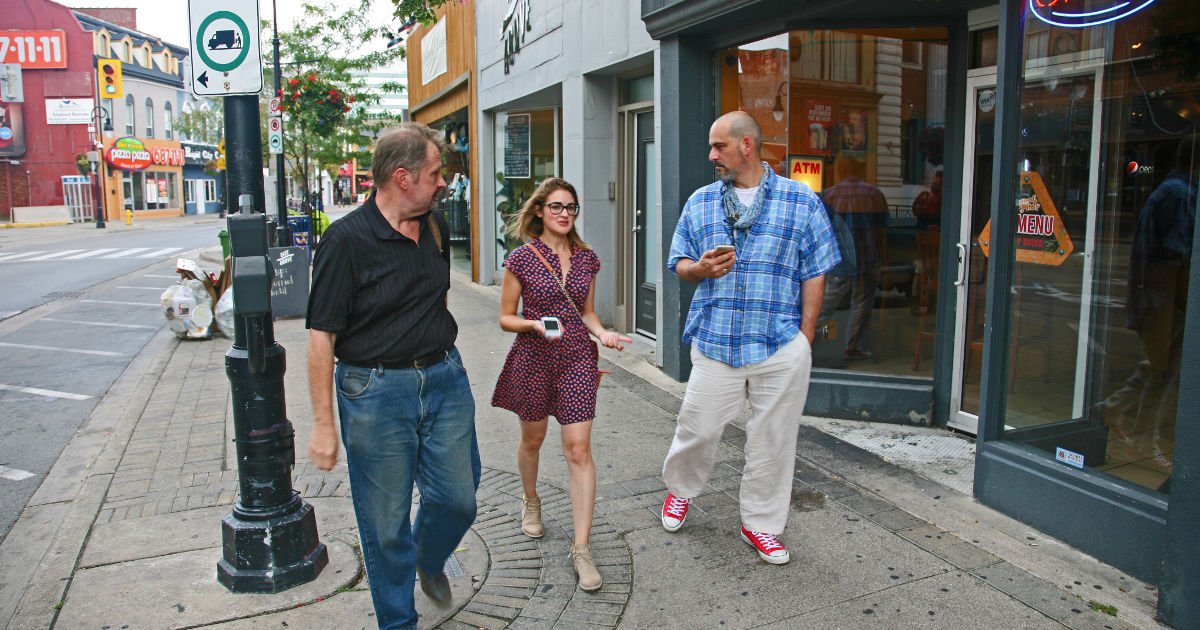Heritage Resonates
The 2016 National Trust of Canada Conference, Heritage Rising, took place this past week in Hamilton. Inspired by the perfect host city - great people, great heritage - a record number of participants engaged in a diverse and lively discussion.
There was something for everyone and far more than anyone could possibly take in, so it will take some time to process all of the incredible information we gathered. What is already clear is that our own planning and work ahead will benefit greatly from the experience, but in the immediate aftermath, certain lessons resonate.
Anarchy in the Mainstream
It is a transformative time in heritage preservation in Canada and worldwide. A spirit of optimism and renewal prevails. In recent months, we have had the opportunity to work with Franklin Vagnone of Twisted Preservation in New York City. Franklin has been at the forefront of the reformist movement in the heritage community and his presentations at the conference were highly anticipated.
Franklin Vagnone presenting examples of progressive heritage preservation at the “Mighty Sites” workshop at Dundurn Castle.
One of the things that we most appreciate about working with Franklin is the dynamic nature of his message. He is always enlightened and enlivened by his ongoing work and each discussion with him, even following soon after the last, brings something new.
One of our takeaways from the conference is that while his manifesto - “The Anarchist’s Guide to Historic House Museums,” written with Deborah Ryan - was seen by many as dangerous and destructive when it was first released (only last year), the ideals and attitudes that it promotes are quickly becoming almost mainstream in any gathering of progressive heritage professionals. The discussion as to whether Franklin is a visionary or a maniac has given way to a broad based examination of experimental ideas and forward-thinking methodologies.
Franklin Vagnone (right) on a walking tour of the St. Catharines Heritage Corridor with Mr. Heritage, Brian Narhi (left) and JBHF’s Theresa Felicetti (centre).
Interesting Developments
Part of the new dynamic involves the heritage community coming to terms with our inclination to be our own worst enemies. As the self-appointed custodians of our inherited historic assets - both physical and spiritual - we can no longer afford to turn people away by presuming to tell them what should be important to them.
This means cultivating an inclusive and diversified constituency, of asking questions and listening to the answers before we presume to make decisions. Broadening our perspectives also means learning the language of economics and development, something to which traditionalists in heritage circles may have difficulty reconciling themselves.
Skeptics should be enlightened to examine successful heritage case studies and examples of leadership coming from unexpected places. Some select examples include: Eve Lewis of Woodcliffe Landmark Properties; Joseph Mancinelli of the Laborers' International Union of North America; and Harry Stinson of Stinson Developments Inc.
Harry Stinson making a point about the commercially desirable qualities of and opportunities offered by heritage properties.
Each of them boast a portfolio of historic properties that have been profitably renovated and re-purposed in a way that engages and rejuvenates the surrounding community, something that should be the primary goal of any heritage restoration project.
Reconciliation and Heritage
Following upon the work of the Truth and Reconciliation Commission, the theme of reconciliation has become an important one in heritage circles and was the subject of this year’s keynote address. Historic sites and organizations are looking to incorporate programming related to First Nations history that has long been overlooked by society and by a single-narrative view of heritage.
Few heritage professionals are better positioned to speak on the topic than Janis Monture, Executive Director of the Woodland Cultural Centre. Woodland was established in 1972 on the site of the Mohawk Institute Residential School that operated in Brantford from 1828 to 1970.
Janis Monture speaking about the legacy of the Mohawk Institute Residential School at the “New Relevance for the Historic Sites” seminar.
With an original mandate to preserve and promote First Nations culture and heritage, the Centre now maintains a balance between remembering and preserving one of the most challenging chapters of Canadian history while celebrating a lively and vibrant community that survives it, which makes the Woodland Cultural Centre one of Canada’s most important heritage sites.
Our Rural Heritage
The preservation of rural and farming heritage is another theme close to our heart and comes with its own unique set of challenges. As the number of small family farms dwindles, our connection to that most central pillar of our cultural heritage becomes more tenuous.
Ella Haley, Executive Director of the Langford Conservancy, leads a group of energetic volunteers dedicated to not just preserving the Langford Schoolhouse as a rural community centre, but also raises money for the Farmland Protection Fund, offering creative ways to protect “One Farm at a Time.”
The Langford Schoolhouse
Equally enthusiastic was Matthew Somerville, a Heritage and Urban Design Planner for the Town of Richmond Hill and a fifth generation farmer. He spoke passionately and pragmatically about his own efforts to preserve heritage barns, including his family barn in Port Perry which he and his husband initially renovated as a venue for their own wedding, but now use to host community gatherings and screenings while moving forward with their plans to outfit it as a small cidery.
Beyond Decay
A session on urban exploration may seem an unlikely addition to our agenda given the semi-rural setting of the Brown Homestead. However, our mindset of looking beyond the expected compels us to seek out different perspectives that may appear at first to have no direct application to our own work, but can inspire innovative ideas and approaches.
The presentations of Jonathan Castellino, Dan Iaboni, and Patrick Cummins offered just that. For them, urban exploration goes beyond an appreciation for the aesthetics of decay. It is a way to make a meaningful connection to an “empty” place. The liberation of experiencing a building outside of its intended purpose and without the constraints of activity and time, heightens one’s awareness and allows for a greater attention to detail.
Abandoned School in Hamilton - photo by Jonathan Castellino, Sacremental Perception
The end result is a deeper exploration of not just the space, but also a more complex engagement with the people and systems that give it life. It is an important lesson for historic sites that seek to share that experience with their visitors.
Conclusion: Moving Forward
It is evident that one of our greatest assets is the clean slate that we have with the Brown Homestead and as a new organization. We have an opportunity to build something meaningful, innovative and self-sufficient rather than having to reinvent ourselves. It is a rare advantage in the heritage sector, but one that comes with pressure to “get it right the first time.”
Attending the National Trust of Canada Heritage Rising Conference in Hamilton has opened up a number of additional avenues of exploration and discovery. It would be easy to become overwhelmed by the myriad of possibilities and responsibilities, but we prefer to embrace the process.
Our founding principal of acknowledging uncertainty and being stewards of open dialogue provides us with direction on how to proceed. If a full expression of multiple relevant narratives can be one of the most powerful tools in preserving heritage spaces, understanding how to present those narratives comes from meaningful relationships with our community, from government officials to regulars in local cafes.
Community discussion at the John Brown House, August 2016
Informed by our newfound lessons and examples, we will continue our community outreach in the coming months. This will involve reaching out to and cultivating relationships with our constituents and stakeholders, not overnight and not for immediate gain, but as a central part of our approach and methodology.
We look forward to continuing to invite more of you to join in the journey of putting these (and other) ideas into practice at the Brown Homestead and elsewhere. And as always, you have an open invitation to let us know what is important to you and how you would like to be involved.









